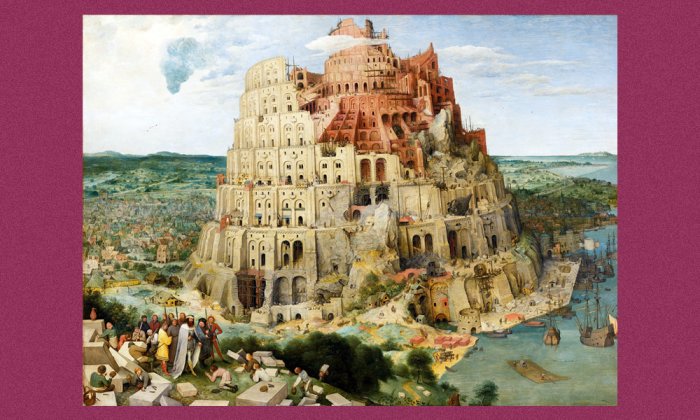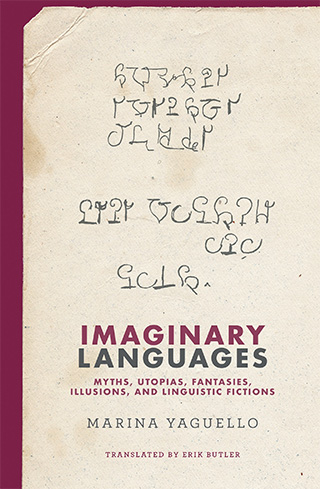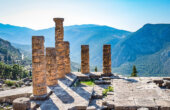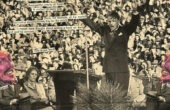The Role of Myth in Language: From Lingua Adamica to Babel

Where does language come from? How can one explain the diversity of languages spoken all over the globe? The function of myth is to explain the questions that human beings ask concerning where they come from.
In Judeo-Christian cultures (and among Muslims, who, we shouldn’t forget, share the same founding myths), the theme of a shared origin and the dispersal that followed it have come to stand as dogma. The Bible provides an account in five stages, divided between the Old and New Testaments. The first four represent foundational events. The fifth enables passage from myth to history.

First, in the Book of Genesis, God gives language to Adam so that he may apprehend the universe. Adam assigns names to creatures and things as he discovers and takes possession of the world, for everything must have a name to exist. “And out of the ground the LORD God formed every beast of the field, and every fowl of the air; and brought them unto Adam to see what he would call them: and whatsoever Adam called every living creature, that was the name thereof.” Such is lingua adamica, the original universal language, an essential component of the dogma of the oneness of God’s children. Up to the dawn of the 20th century, the Church held to the thesis of monogenesis with all its might and refused Darwin’s theory of evolution. Indeed, to admit a plural origin of language would mean accepting that Adam was not the ancestor of humanity as a whole.
To admit a plural origin of language would mean accepting that Adam was not the ancestor of humanity as a whole.
Of course, lingua adamica was the most vital part of the myth. As dogma, it had to be defended and affirmed, which gave rise to a truly fantastical strain of scholarship (could it have been otherwise?) on the divine origins of language, which didn’t end until the 19th century. This did not mean, however, that the search for the mother tongue of humankind ceased — far from it; scholars simply no longer assumed that it was a matter of celestial benefaction. In fact, from 1866 on (when the Société de linguistique de Paris was founded), the enterprise continued at the margins of official learning. The torch had passed to “literary madmen.” Only at the end of the 20th century, mainly in the United States and Soviet Union (then Russia), would the project return with an air of general respectability, now in the context of advances in the fields of paleontology and human origins.
The next part of the Biblical account is the Flood. Only Noah and his descendants escape destruction. Where did Noah manage to build his ark? What if, as John Webb surmised in the 17th century, he had done so in China? This land was eminently suited to the enterprise. It followed that the language in use before the Flood was Chinese. There was no limit to Webb’s esteem for Chinese art and culture. In his eyes, the language of people here had retained its original purity. The Westerners of the day had to come to terms with the antiquity of Chinese civilization, which threatened ideas about European preeminence. What’s more, the writing system used throughout Chinese territory erased dialectal differences, which commanded further admiration. Webb had struck upon a way of “recuperating” China for standing notions without imperiling the Bible or Christian orthodoxy. Simon Berington took up the same line of argument in 1750.
Indeed, what if certain, exceptionally high mountains had escaped the Flood altogether? The search for traces of the Garden of Eden — and thus the Adamic language — shifted to elevated sites, and even to the Moon, since it had escaped the cataclysm, too. Scholastic thinkers held the latter opinion. As late as 1884, the Flood still provided the basis for arguments in favor of a monogenetic origin, language given by God. To counter evidence that the myriad languages in existence could not derive from the same mother tongue, a certain Georges de Dubor got around the problem by claiming that the waters had not reached the black, red, and yellow races; if the Semites, Hamites, and Aryans make up a single racial and linguistic family descended from Noah, other races and languages do not belong to this lineage.
The question of where to situate Paradise — both the earthly one, where Adam and Eve lived, and the heavenly one, where departed souls abide — represents a point of intersection between linguistic and topographical imaginaries. Like the Greeks (Plutarch, for instance), Gaulish druids deemed the Moon to be the heavenly body to which souls ascend upon death. Such belief passed into Christian belief, in various forms. Indeed, it’s hardly surprising, since Paradise must be located somewhere hard to reach (if it’s not altogether imaginary — like the lost continent of Atlantis); hence the coincidence of paradisiacal and utopian topoi. The bowels of the Earth, on the other hand, have traditionally been thought to contain Hell, the topos of anti-utopias.
Ariosto’s “Orlando Furioso” tells how Astolfo journeys to the kingdom of the Moon, a kind of paradise where everything lost by mortal men and women is now to be found: the sighs and tears of lovers, vanished time, unrealized projects, reason, and common sense. In Dante’s “Commedia,” the poet travels down through the circles of Hell, arrives at the heart of the Earth, and comes back out at the Antipodes, where earthly Paradise and Purgatory are located; then he passes upward and onward to each of the seven heavens matching the seven planets (as understood at the time): the Moon, Mercury, Venus, the Sun, Mars, Jupiter, and Saturn. These celestial bodies all house souls. The uppermost spheres of the cosmos belong to fixed stars and the Primum Mobile. The Empyrean realm crowns it all; here dwell the saints and angels of Heaven.
The voyage Cyrano de Bergerac describes in “The States and Empires of the Moon” (1656) reveals a paradise lost to the Earth after the Fall. There he meets a young man named Mada, a transparent anagram of Adam. First on the Moon — then later on the Sun — the voyager finds ideal languages in use. In a very different spirit, Emanuel Swedenborg claimed to have made a similar journey in 1758 and to have discovered the first language of humankind on Jupiter. Finally, in the late 19th century, the spiritualist Hélène Smith communicated first in Martian, then in Uranian, with disembodied spirits that had ascended to the heavens.
The third foundational event recounted in the Old Testament is also the most familiar: the construction of the Tower of Babel and the confusion of languages that ensued — a kind of second Fall cementing the effects of the first once and for all. Babel is the Hebrew word for Babylon, or Bab-ili, which means “Gate of God.” The text in Genesis (11:9) contains a pun, playing between bab-el and bal-el (“He confounds, confuses”): “Therefore is the name of it called Babel; because the Lord did there confound the language of all the earth: and from thence did the Lord scatter them abroad upon the face of all the earth.”
From the 16th to the 20th centuries, in parallel to the search for an original language, the project of constructing a universal language thrived.
The myth of Babel represents the necessary counterpart to the myth of the Adamic language, shining light on the mystery of the many tongues spoken by human beings and the lack of concord between them. At the same time, it opens the prospect that order, which once existed, will again prevail. Thus did myth give birth to utopia. From the 16th to the 20th centuries, in parallel to the search for an original language — traces of which were presumed to exist among one remote tribe or another that didn’t participate in building the accursed tower — the project of constructing a universal language thrived.
We now turn to the New Testament. If Christ has come to redeem Man, the creature once driven from Paradise, he also — and this fact is not as well known — comes to put an end to the curse of Babel. This happens in two stages.
The first is the miracle of Pentecost, which has been interpreted in different ways. Either it enables the Apostles to speak the foreign languages of those who have come from many lands to hear them (the first case of xenoglossia), or it means that although they speak Aramaic, their listeners can understand them as if they were speaking each man or woman’s native tongue (in Chomskyan terms, one might say that communication is occurring at the level of deep structure, guaranteeing the oneness of human language). Alternatively, the Apostles express themselves in a kind of mystical Esperanto — a new language that revives the lost lingua adamica. Note the profound implications of the Pentecost for theology: Banishment from Eden and the curse of Babel are the work of a vengeful deity; the Christian God is a God of mercy.
A second manifestation of divine grace in language — which, appearances notwithstanding, is quite different — occurs in Paul’s First Epistle to the Corinthians (13 and 14). Here, one reads of a singular practice that has emerged in the Primitive Church: “speaking in tongues.” In contrast to what happened at Jerusalem on the day of Pentecost — the miracle of perfect intelligibility without the aid of translation, pellucid communication — at Corinth the faithful speak languages that neither they nor their listeners understand; by this means, the Holy Spirit places them in direct communion with God. Unlike xenoglossia, which occurs in an identifiable language, glossolalia involves a language unknown to speakers and listeners. This is not communication between one human being and another, but between a person (or persons) and the Deity (or spirits from the other world).
Rise up, speak or make a sound — keep making sounds, and the Lord will turn them into a language, urged Joseph Smith, the founder of the Church of Jesus Christ of Latter-day Saints. Yet there will always be confusion between two orders of phenomena. Even though Mormonism and Pentecostalism affirm the miracle of xenoglossia (which involves human languages), they are essentially reliant on glossolalia (supernatural tongues).
Without condemning glossolalia altogether, Saint Paul voiced strong reservations. He set the “gift of tongues” — an emotional (if not infantile) outpouring — in opposition to prophetic speech, which addresses the intellect. In fact, Corinthian glossolalia marks the passage from the realm of myth to History, writ large — the first instance on record of a linguistic practice occupying a defined historical position oriented and justified in terms of myth.
Yet myth precedes science and history, and it perpetuates itself even as history unfolds and science advances. Though assigned a lesser status, it animates human endeavor, representing the most universal form of thought and, in this capacity, shaping worldly events.
After all, doesn’t myth — if on another register — say the same thing as science? Doesn’t it unveil the truth in a different light, fusing the worlds of imagination and of reason?
Marina Yaguello is Professor Emerita of Linguistics at the University of Paris VII and the author of “Imaginary Languages,” from which this article is excerpted.



